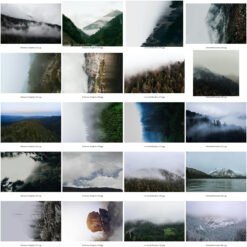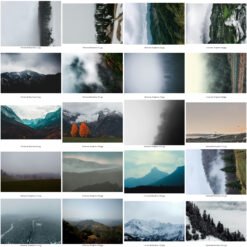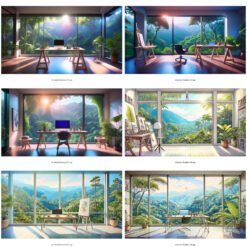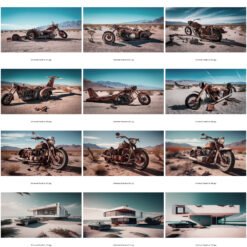Introduction to Double Exposure Photography
Double exposure photography, a technique that layers two different images to create a single, composite photograph, has a rich historical background. Originating in the days of film photography, this method was initially achieved by exposing the same frame of film twice. This approach allowed photographers to experiment with surreal and artistic effects, combining elements that would otherwise remain separate in reality.
The evolution of double exposure photography has been marked by significant technological advancements. With the advent of digital photography, the technique has become more accessible and versatile. Digital cameras and photo-editing software now enable photographers to execute double exposure with greater precision and creativity. This digital resurgence has breathed new life into the practice, allowing for more intricate and high-quality compositions, especially in 4K quality.
The basics of double exposure involve carefully selecting two images that complement or contrast with each other. The first image typically serves as the background, while the second image is superimposed to add texture, depth, or an abstract element. This fusion can result in a variety of visual effects, ranging from dreamy and ethereal to stark and dramatic. The key to a successful double exposure lies in the thoughtful blending of these elements to create a harmonious and visually striking photograph.
Today, double exposure photography is immensely popular among photographers and artists for several reasons. It offers a creative outlet to explore new artistic horizons and push the boundaries of conventional photography. Moreover, the technique allows for the expression of complex themes and narratives through a single, blended image. The allure of double exposure lies in its ability to transform ordinary subjects into extraordinary works of art, capturing the imagination of both the creator and the viewer.
Essential Equipment and Software for 4K Double Exposure
Creating stunning double exposure backgrounds in 4K quality necessitates the use of specialized equipment and software. To begin with, a high-resolution camera is indispensable. Cameras with at least 24 megapixels are recommended to capture the fine details required for 4K double exposure images. Popular choices include the Canon EOS R5, Sony A7R IV, and Nikon Z7 II. These cameras offer excellent resolution and dynamic range, which are critical for achieving the layered effects in double exposures.
A quality lens is equally important. Prime lenses such as the Canon RF 50mm f/1.2L, Sony FE 24-70mm f/2.8 GM, and Nikon Z 50mm f/1.8 S are well-regarded for their sharpness and depth of field, making them suitable for double exposure photography. Additionally, a sturdy tripod is essential for stability, particularly when capturing images that require long exposures or multiple shots to be merged later.
On the software front, Adobe Photoshop remains the industry standard for creating double exposure images. Its advanced layering capabilities and extensive array of blending options make it the go-to tool for professional photographers. Adobe Lightroom is also useful for initial photo adjustments and cataloging. Other notable software includes Affinity Photo and GIMP, which offer similar functionalities at different price points.
When selecting hardware and software, compatibility and user-friendliness should be considered. Ensuring that your camera and lenses are compatible with your editing software can streamline the workflow. Additionally, investing in a high-performance computer with ample RAM and a powerful graphics card can significantly enhance the editing process, allowing for smoother manipulation of high-resolution files.
In summary, achieving the best results in 4K double exposure photography hinges on the combination of high-quality equipment and robust software. By carefully selecting the right tools, photographers can create visually stunning and intricate double exposure backgrounds.
Step-by-Step Guide to Creating Double Exposure Backgrounds
Creating stunning double exposure backgrounds in 4K quality involves a series of meticulous steps, starting with the selection of the right images. The choice of images can significantly impact the final result, so it’s crucial to pick high-resolution photos that complement each other. Opt for a primary subject with a clear silhouette and a secondary image that adds texture or storytelling elements.
Once you have your images, open your preferred photo editing software, like Adobe Photoshop. Begin by importing both images into the workspace. Position the primary image as the base layer and the secondary image above it. To start blending, adjust the opacity of the top layer. Lowering the opacity allows the base layer to show through, giving an initial double exposure effect.
Next, use masking techniques to refine the blend. Add a layer mask to the top image and use a soft brush to paint black over areas where you want the base image to be more prominent. This step is crucial for creating a seamless integration between the two images. Take your time and adjust the brush opacity to achieve subtle transitions.
Blending modes are another powerful tool in your double exposure toolkit. Experiment with different modes like “Screen,” “Overlay,” or “Multiply” to see how they affect the interaction between the layers. Each mode will produce a different visual effect, so choose the one that best enhances the overall composition.
Fine-tuning is essential for achieving a professional look. Adjust the levels, curves, and color balance to ensure both images harmonize well together. Pay attention to details, such as aligning key elements and ensuring that the combined image maintains a cohesive color scheme.
Finally, save your project in 4K resolution to preserve the high-quality details. Export your image in a format like PNG or TIFF to maintain the best possible quality. By following these steps, you can create breathtaking double exposure backgrounds that captivate and inspire.
Creative Ideas and Inspirations for Double Exposure Effects
Double exposure photography is an art form that allows for endless creativity and experimentation. By blending two distinct images into one, photographers can craft visually stunning compositions that evoke emotions and tell unique stories. Here are some creative ideas and inspirations to help you explore the possibilities of double exposure effects, especially with 4K quality for sharp and vibrant results.
An intriguing approach is to combine portraits with landscapes. This technique often results in mesmerizing visuals where the contours of a person’s face seamlessly integrate with sweeping natural vistas. Imagine a serene forest or a majestic mountain range appearing within the silhouette of a subject’s profile. This method not only highlights the beauty of both elements but also creates a sense of harmony between humanity and nature.
Another captivating idea is to merge urban scenes with natural elements. This juxtaposition can create striking contrasts and thought-provoking imagery. For instance, overlaying the bustling architecture of a cityscape with the tranquil beauty of a forest can symbolize the intersection of civilization and the natural world. Such compositions can evoke reflections on urbanization, environmental conservation, and the coexistence of different worlds.
For those who enjoy abstract art, experimenting with abstract artistic compositions can lead to genuinely unique creations. Mixing textures, patterns, and colors from various sources can produce visually stimulating images that challenge traditional perceptions. This technique is perfect for pushing the boundaries of conventional photography and exploring the interplay between reality and imagination.
Finding inspiration for double exposure photography can be as simple as observing your everyday surroundings. Pay attention to the details around you – the play of light and shadow, the patterns in nature, or the textures in urban environments. By being mindful and curious, you can discover countless elements to incorporate into your double exposure projects.
Lastly, look to contemporary artists and photographers who excel in double exposure techniques for inspiration. Artists like Dan Mountford, Christoffer Relander, and Brandon Kidwell are known for their exceptional double exposure work. Studying their portfolios can provide valuable insights into creative processes and innovative approaches, encouraging you to think outside the box and develop your unique style.
PRODUCT DETAILS:
- Templates Type: Double Exposure JPG Background
- Resolution: 4k High Quality
- File Format: JPG
- Use In: Background (Copyright Free)
WHAT YOU’LL GET:
- 100+ JPG
- 1 ZIP FILE
- 158 MB FILE SIZE(ZIP)



















Reviews
There are no reviews yet.